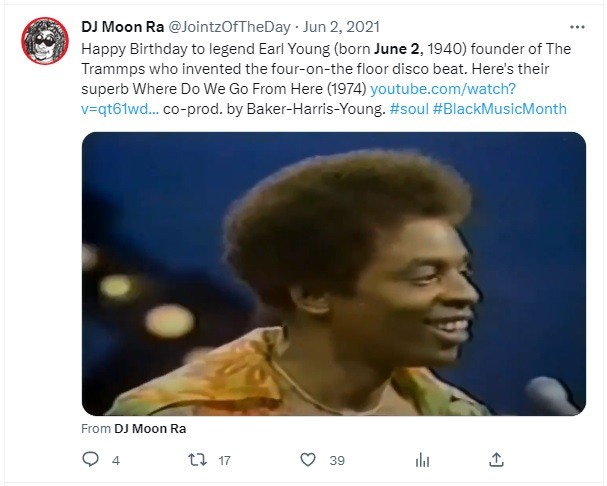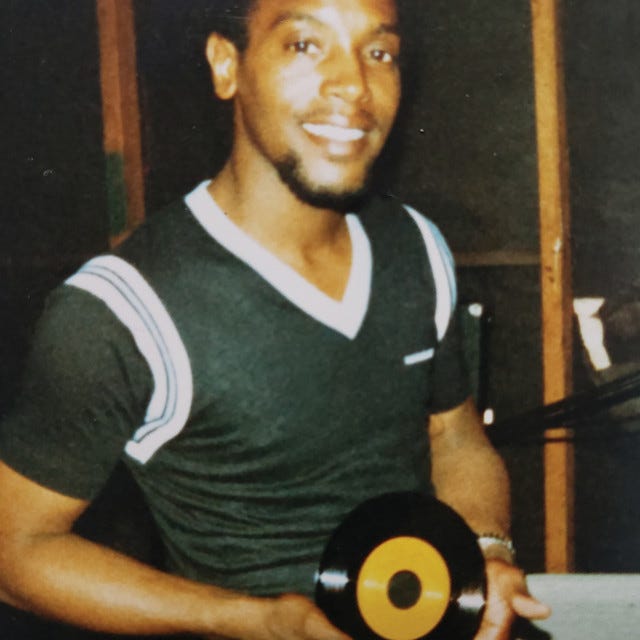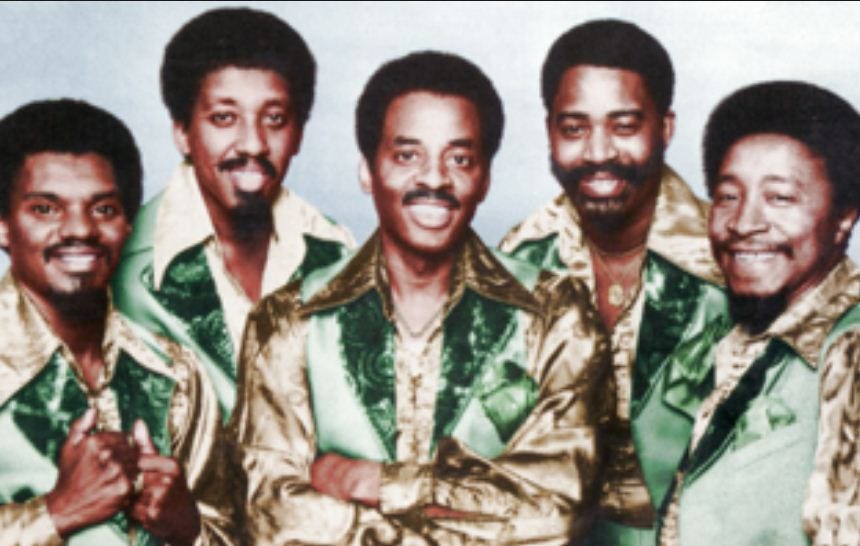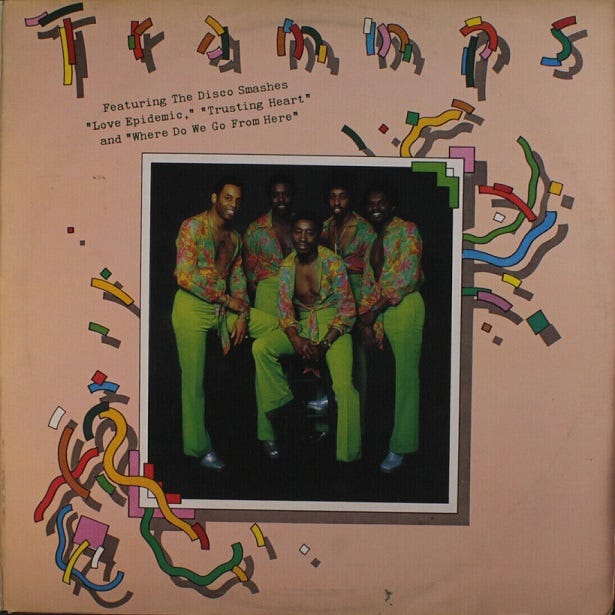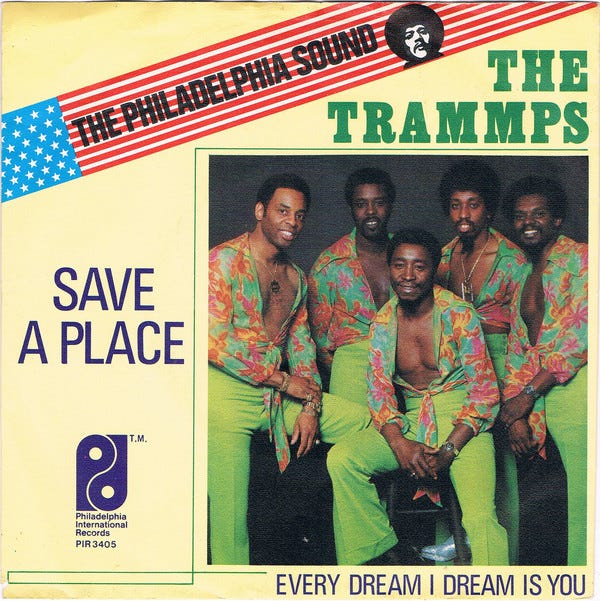Earl Young (born June 2, 1940) – Where Do We Go From Here (1974)
Written by Ronnie Baker and produced by Baker-Harris-Young, this superb jam off the Trammps' debut LP was the last record ever played at the Paradise Garage.
Watch full video on Twitter.
View most updated version of this post on Substack.
The legendary drummer, vocalist, songwriter and producer Earl Young was one of the original members of MFSB, a founder of the Trammps, a key player in the Salsoul Orchestra, and one third of the Baker-Harris-Young production team. He is best known for inventing the foundational four-on-the-floor drum pattern that provided disco with its backbeat and changed the course of dance music history.
Earl Donald Young was born in Philadelphia. He began his professional career as a drummer in the house band at the city’s Uptown Theater.
For an overview of how Young became an original core member of MFSB, the house band for Philadelphia International Records, and his later work as part of the B-H-Y (Baker-Harris-Young) production team, see our post from March on Norman Harris.
While playing drums on the recording session for the #1 R&B hit “The Love I Lost” (1973) by Harold Melvin and the Blue Notes, Young improvised what became known as the four-on-the-floor drum pattern. It was widely imitated and ended up on thousands of records, becoming the signature sound of disco.
Young was an original member of the Trammps, which grew out of a 60s R&B group called the Volcanos, later re-named the Moods. Its members were Young, lead vocalist Gene Faith, singer Jimmy Ellis, Dennis Harris on guitar, the great keyboardist Ron “Have Mercy” Kersey, John Hart on organ, bassist Stanley Wade, and Michael Thomas on drums.
By the time they changed names again and became the Trammps in the early 70s, Ellis was on lead vocals, Young handled bass vocals and drums, Norman Harris played guitar, and Stanley Wade was on bass, with his brother Harold “Doc” Wade on guitar and vocals.
Young sang lead on the Trammps’ debut single “Zing! Went the Strings of My Heart” (1972), an upbeat cover of a Judy Garland standard, which was released on Buddah Records and went to #17 R&B.
For another of their early singles, Young memorably delivered the spoken word intro to the superb jam “Where Do We Go From Here” (1974) as well as drumming on the track and co-producing it with Norman Harris and Ronnie Baker. The song hit #44 R&B and the following year was included on their debut self-titled album, released in April, 1975 on Golden Fleece Records, a PIR subsidiary that was run by Baker, Harris and Young.
“When disco came out, we had just left Philadelphia International Records and signed with Atlantic, and we had out 'Where Do We Go From Here?',“ Young recalled in a 2013 interview.
“Ronnie Baker decided, 'Let's cut a song called, 'That's Where the Happy People Go,' — to the disco,' and we cut 'That's Where the Happy People Go' and 'The Night the Lights Went Out [in New York City],' and that started us out as disco. We were selling records, so Atlantic said, 'Well, let's keep 'em disco!'“
On September 28, 1987, early Monday morning around 2 am after an epic weekend-long closing party, DJ Larry Levan put “Where Do We Go From Here” on the turntables. It was the last record ever spun at the Paradise Garage.
“Not only do I think disco is unsung, I think the Trammps are unsung,” said Young in 2013.
“A lot of people had the wrong idea about disco. They think that disco is bad music, but it's not. In every group of music, there are some bad songs and there are some good songs. There's bad songs in R&B, there's bad songs in every sort of music. So when disco jumped off, everybody thought they could take that four-on-the-floor beat of mine and that sock cymbal, and put out 'Disco Duck,' disco this and disco that, and everybody threw one of those mirror balls in their little bar and called it a disco!”
Trammps was recorded at Sigma Sound Studios. It reached #30 on the R&B album charts and peaked at #159 on the Billboard 200. The LP also featured the disco masterpiece “Save A Place,” written by Baker and produced by Baker, Harris and Young.
Further info:
“Rock and Roll; Make it Funky; Interview with Earl Young [Parts One and Two],” WGBH, September 1995.
“Trammps' Earl Young brings Philly flavor to ‘Unsung’,” by Kimberly C. Roberts, Philadelphia Tribune, February 14, 2013.
#soul #funk #disco #MFSB #BHY #PIR #Trammps #EarlYoung



